This article was originally published in the June 2013 issue of The Rivah Visitor’s Guide.
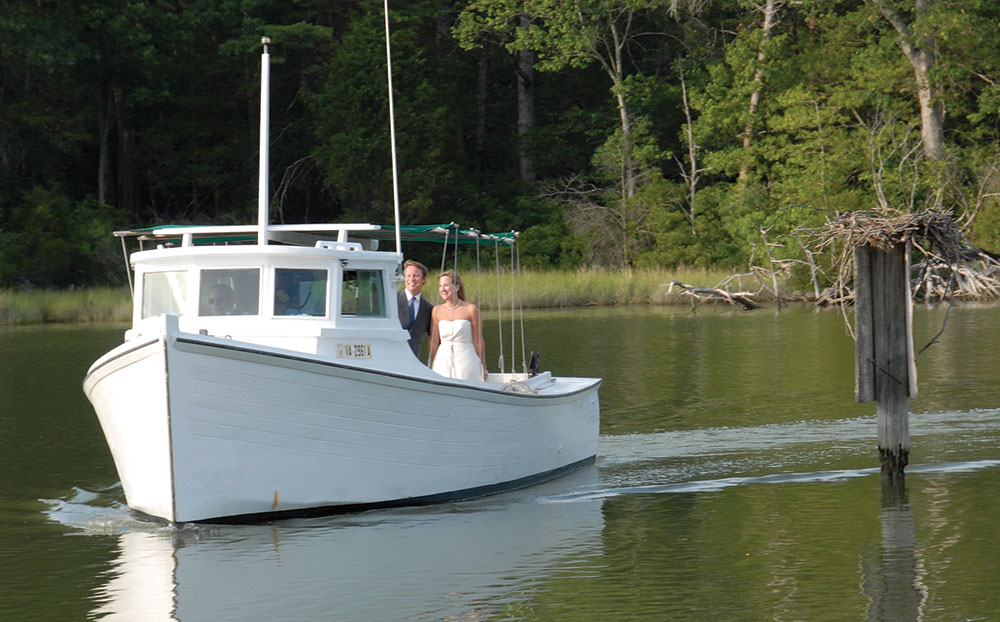
by Larry Chowning –
The Northern Neck and Middle Peninsula have proved to be powerhouses in the development of wooden deadrise boat construction, and the era has lasted from the 1880s well into the 21st century.
There are still a few wooden boatbuilders around, but the industry has just about played out as most boat owners now prefer low-maintenance fiberglass and steel hull boats.
Some folks, however, still desire the aura and feel of a wooden deadrise under way. The origin of the use of the term deadrise has created debate. The late Frances Haynie of Northumberland County built boats most of his life and said the term deadrise was related to dead wood. When building the vee in a Chesapeake Bay deadrise, short boards called “staving” are used. Haynie referred to the ends of staving wood that were cut off to even out the vee as dead wood. He believed the dead in deadrise refers to the wood and the rise in deadrise refers to the relatively straight-up-and-down position of the staving when installed. The vee usually runs along all bottom planking on a wooden boat, from the bow to near the stern. There is, however, a pronounced vee in the bow that flattens out as it is carried aft toward the stern.
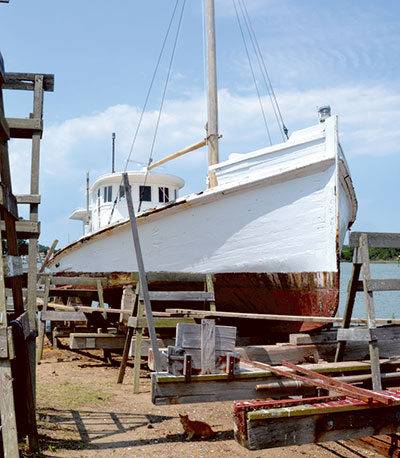
The most popular theory though is that dead is a colloquial term to denote a straight rise, thus the term deadrise. An official definition of deadrise is the “dead” straight rise of the wood from the keel rabbet (where the staving attaches to the keel) to the chine. The chine is a seam where longitudinal side planks and the vertical cross planks come together.
Over time, the use of the word deadrise became more associated with the entire boat than in the vee-planking and cross-planked bottoms. That is why today people refer to the vee-bottom and cross-planked boat, in a general way, as the Chesapeake Bay deadrise.
The boat has become so prominent that on March 25, 1988 Virginia legislators voted to make the Chesapeake Bay deadrise the official boat of the state. The skipjack, which also has a deadrise and cross-planked bottom, became the official boat of Maryland in 1985.
The construction of deadrise and cross-planked boats on the bay started in the 1880s and would spread throughout the region in Maryland and Virginia.
The largest deadrise boat ever built was the Marydel, built by Linwood Price of Deltaville in 1927 for the W.E. Valliant Company. It was built to haul fertilizer. Deadrise boats ranged in size from 12 feet to over 100 feet.
Although there are many deadrise boats still working in the bay’s commercial fishing industries, there also are many that are being purchased and converted with love and care into pleasure boats.
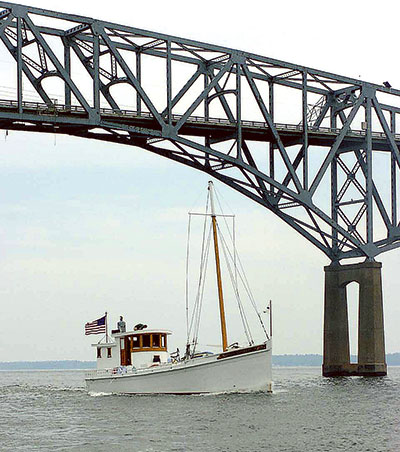
Bill Kurz of Urbanna is a retired commercial airplane pilot and moved to his home on Robinson Creek near Urbanna in the 1990s. He has had a deadrise wooden boat since 1999 and uses it for pleasure. It has become part of his family.
“I’d always wanted a wooden deadrise boat,” said Kurz. “I like the lines and I like the ride in the water. I wanted a heavy, comfortable boat to take my family out on the river.
“I like wood and I like to fix things that need to be repaired, and I don’t mind doing the annual maintenance myself,” he said. “It’s really a good fit for me.
“When you have these boats and use them for pleasure, you get in the fix of deciding how much you want to improve it to make it more comfortable,” Kurz said. “I try to keep it true to the old ways. I have not added electronics or changed the shape of it. I did put an awning on it. When I first got it, the late Alvin Sibley (a local boatbuilder) had put a new cabin and a new bottom on it. I knew I was getting a good boat.
“I’m always chasing wood rot and painting and scraping,” he said. “It’s got a 4-53 Detriot Diesel engine in her. It’s a little noisy but it sips gas. It doesn’t burn but 2.5 gallons per hour.
“I feel a link to the past every time I take it out,” Kurz said. “These boats evolved on the bay because the boats’ deadrise bottom cut through the short choppy seas and provided a very smooth ride.”
Bill Hight of Urbanna owns four wooden deadrise boats, including one he has owned for 30 years. He has recently refurbished a 55-foot deadrise buyboat that he has named the 55th Virginia. Hight’s great-grandfather, William Steptoe Christian, was a colonel in the Confederate Army’s 55th Virginia infantry regiment during the Civil War, and he named the boat in honor of that regiment.
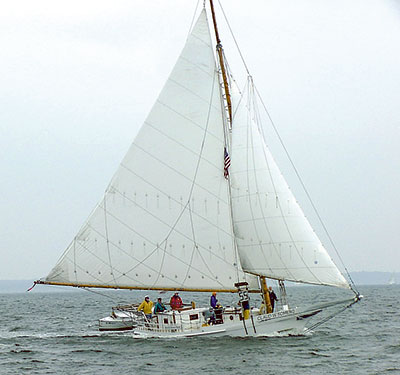
“The beauty of a good deadrise boat is unsurpassed,” said Hight. “I grew up around the boats. I always liked the shape and the ride of a deadrise.”
People just like the way they look and ride. For some people it’s a nostalgic thing. One of Hight’s boats is a 35-foot sedan cruiser built by Linwood Price. It has a traditional deadrise hull with a yacht shape.
“It is a wonderful overnight boat,” said Hight. “We went to Tangier Island in her for the buyboat rendezvous a few years ago. Three of us spent the night on her, cooked on her, lived on her for several days, and we were as comfortable as if we were at home.
“If you take care of a wooden boat it will last you a long time,” he said. “It’s a great family boat for bottom fishing and cruising. It has a great feel and smell to it.”
Hight and Kurz emphasize that these boats need tender loving care. “You have to maintain the boats. They are not as forgiving as a fiberglass boat,” said Hight. “Not just anyone can do the wood maintenance on these boats.”
This is becoming an ongoing problem as those with the skills to work on a wooden boat are passing on. “There used to be a wooden boatbuilder in every neighborhood. Now you are lucky if you have one good one in a county,” said Hight.
Hight loves owning his boats. “You know you’ve got something special when you ride by a group of boats in the river and everyone, and I mean everyone, turns their heads to look at your boat.”
Aboard a deadrise named Miss Susan
For anyone whose family grew up on the Northern Neck or Middle Peninsula before fiberglass boats came along, they most likely have a story or two regarding a wooden deadrise boat.
I’m no different. I grew up in Urbanna in the 1950s and 60s and we always had wooden boats. Mine was a 12-foot John Wright built flat-bottom wooden skiff. My sister had a 8-foot round bilge sailing cat boat. The family boat was a deadrise 38-footer, named Miss Susan after my sister, that had been built originally as a watch boat used to patrol oyster grounds and keep poachers away. It was powered by a flat-head Grey marine engine.
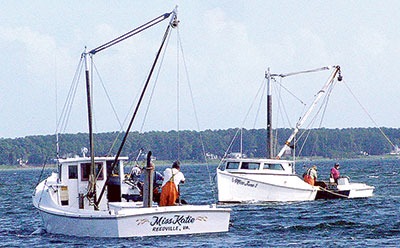
I ate more fried chicken and caught more spot and croaker on that boat than anywhere else in my life. Every year when warm weather came, the boat was hauled and painted and almost every weekend we went bottom fishing. A World War II Navy Seabee, Dad could not live without a boat.
My mother’s oldest sister, Phyllis Bray and her husband Harry, their daughter Sharon, and sons Wayne, Jerry and Mark often went on fishing trips with us. Uncle Harry was a rather large man and this would be clearly emphasized on one particular trip.
We never went far from the mouth of Urbanna Creek and on this day we were bottom fishing on Hoghouse Bar, not far from the mouth of the creek, when a summer squall struck. When it started raining cats and dogs, everyone, except Dad, piled into the cabin. Dad stayed out in the rain, pulled the anchor, started the engine, and stood in the rain as he steered the boat home.
As time passed, my mother realized we were not moving very fast. ‘What’s the matter Shep?” she asked my dad. “Why aren’t we moving?”
Dad bent over from the wheel, stuck his head in the cabin with water running down his face and said, “Emily there’s so much weight in the cabin the propeller is out of the water. Somebody’s got to come out here and sit down on the stern seat to make it go down in the water.”
Lightning was flashing, and at first everyone just looked at one another. Finally my mother and Aunt Phyllis went out and sat down on the stern seat with rain pouring on their heads. “Harry Bray get out here and help us,” Aunt Phyllis yelled.
Uncle Harry was a fine man but was scared to death of lightning and would not move one inch from that cabin. Fortunately, there was enough weight on the stern to push the prop down far enough to get us home.
The fun of those days is that they provided us with fodder for tales like the one just told. That fishing trip is remembered by all who were there, and has been often repeated around our family dinner table.
We don’t have the Miss Susan any more. She has, most likely, long gone to wooden boat heaven—but we still have the memories!


